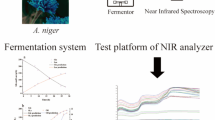Abstract
Near-infrared spectroscopy has manifested its merits and great potentials in various areas. In the modern fermentation industries, near-infrared spectroscopy technique has been utilized for monitoring the quality of raw materials and products, and controlling the whole fermentation process. In this study, near-infrared spectroscopy was used to monitor the leucine fermentation by Corynebacterium glutamicum. A model for the prediction of leucine concentration was established, which had a R2 of 0.9905. The prediction values calculated using this model well fitted the true values, which suggested that the method could accurately predict and monitor the fermentation process.
Access this chapter
Tax calculation will be finalised at checkout
Purchases are for personal use only
Similar content being viewed by others
References
Roggo Y, Chalus P, Maurer L et al (2007) A review of near infrared spectroscopy and chemometrics in pharmaceutical technologies. J Pharmaceut Biomed 44:683–700
Sakudo A (2016) Near-infrared spectroscopy for medical applications: current status and future perspectives. Clin Chim Acta 455:181–188
Gillespie GD, Everard CD, Mcdonnell KP (2015) Prediction of biomass pellet quality indices using near infrared spectroscopy. Energy 80:582–588
Kovalenko IV, Rippke GR, Hurburgh CR (2006) Determination of amino acid composition of soybeans (Glycine max) by near-infrared spectroscopy. J Agr Food Chem 54:3485–3491
Yeung KS, Hoare M, Thornhill NF et al (1999) Near-infrared spectroscopy for bioprocess monitoring and control. Biotechnol Bioeng 63:684–693
Scheeren TWL, Schober P, Schwarte LA (2012) Monitoring tissue oxygenation by near infrared spectroscopy (NIRS): background and current applications. J Clin Monit Comput 26:279–287
Reich G (2016) Mid and near infrared spectroscopy. Anal Tech Pharm Sci 61–138
Xiao X, Hou Y, Du J et al (2012) Determination of main categories of components in corn steep liquor by near-infrared spectroscopy and partial least-squares regression. J Agr Food Chem 60:830–7835
Arnold SA, Gaensakoo R, Harvey LM et al (2002) Use of at-line and in-situ near-infrared spectroscopy to monitor biomass in an industrial fed-batch Escherichia coli process. Biotechnol Bioeng 80:405–413
Fazenda ML, Dias JM, Harvey LM et al (2013) Towards better understanding of an industrial cell factory: investigating the feasibility of real-time metabolic flux analysis in Pichia pastoris. Microb Cell Fact 12:51
Hermann T (2003) Industrial production of amino acids by coryneform bacteria. J Biotechnol 104:155–172
Jojima T, Noburyu R, Sasaki M et al (2015) Metabolic engineering for improved production of ethanol by Corynebacterium glutamicum. Appl Microbiol Biot 99:1165–1172
Eggeling L, Bott M (2015) A giant market and a powerful metabolism: l-lysine provided by Corynebacterium glutamicum. Appl Microbiol Biot 99:3387–3394
Otten A, Brocker M, Bott M (2015) Metabolic engineering of Corynebacterium glutamicum for the production of itaconate. Metab Eng 30:156–165
Gui Y, Ma Y, Xu Q et al (2016) Complete genome sequence of Corynebacterium glutamicum CP, a Chinese l-leucine producing strain. J Biotechnol 220:64–65
Acknowledgements
The authors are very grateful for the financial support from the Foundation (No.2016IM104) of Key Laboratory of Industrial Fermentation Microbiology of Ministry of Education and Tianjin Key Lab of Industrial Microbiology (Tianjin University of Science & Technology), and the Foundation for Young Teachers of Tianjin University of Science and Technology (Grant No.2016LG11).
Author information
Authors and Affiliations
Corresponding author
Editor information
Editors and Affiliations
Rights and permissions
Copyright information
© 2018 Springer Nature Singapore Pte Ltd.
About this paper
Cite this paper
Wei, H. et al. (2018). Near-Infrared Spectroscopy for the Monitoring of Leucine Fermentation in Corynebacterium glutamicum . In: Liu, H., Song, C., Ram, A. (eds) Advances in Applied Biotechnology. ICAB 2016. Lecture Notes in Electrical Engineering, vol 444. Springer, Singapore. https://doi.org/10.1007/978-981-10-4801-2_50
Download citation
DOI: https://doi.org/10.1007/978-981-10-4801-2_50
Published:
Publisher Name: Springer, Singapore
Print ISBN: 978-981-10-4800-5
Online ISBN: 978-981-10-4801-2
eBook Packages: Chemistry and Materials ScienceChemistry and Material Science (R0)




